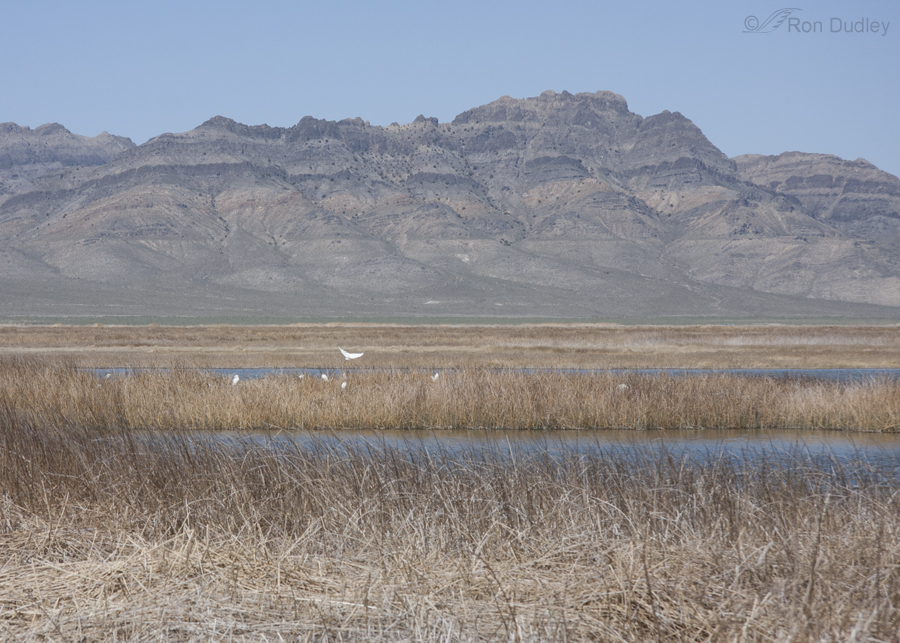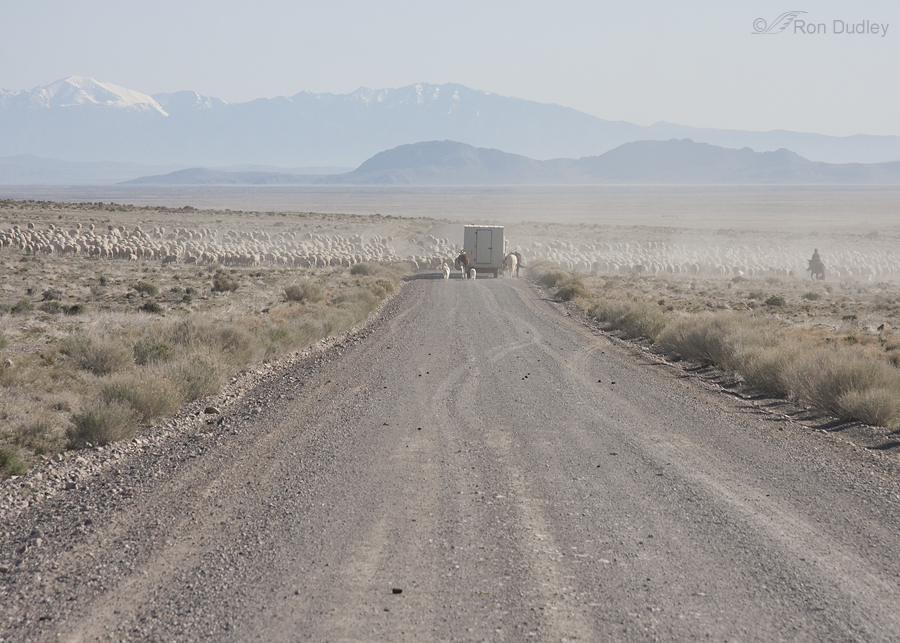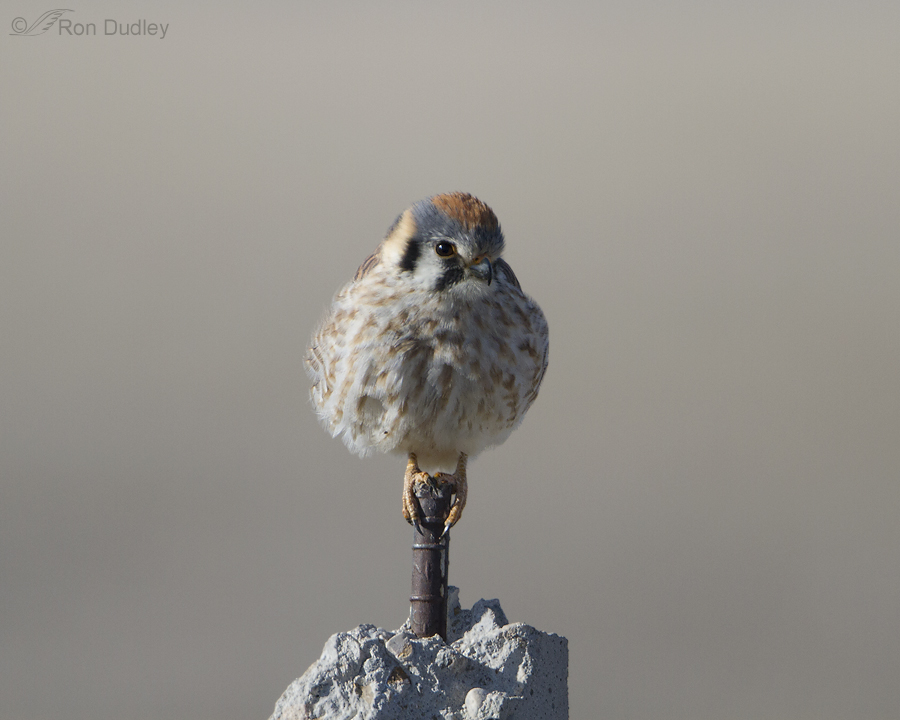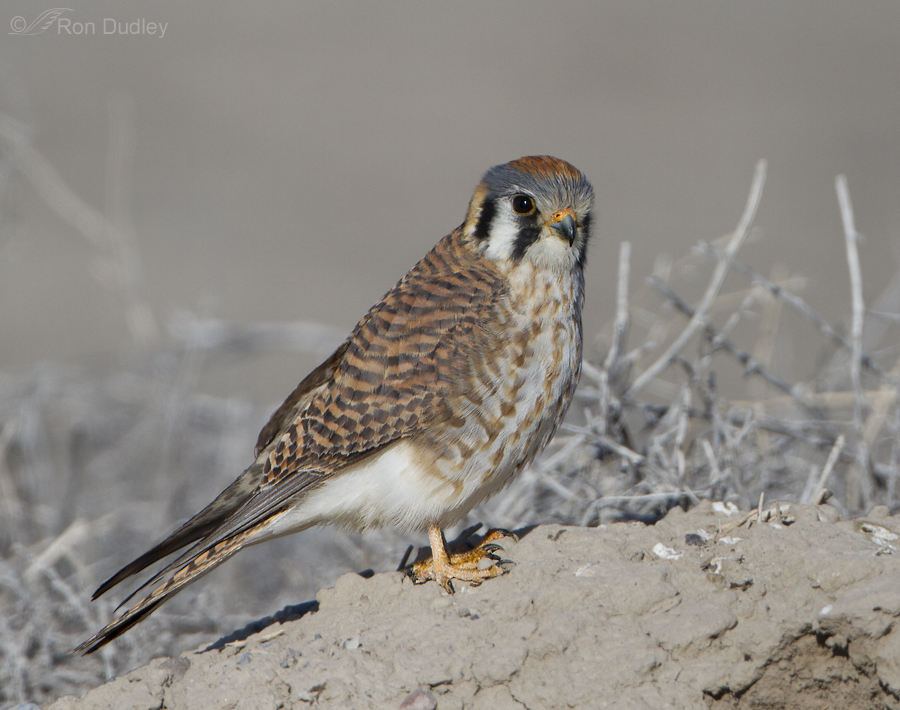During our camping trip to the west desert last week we decided to pay a visit to Fish Springs National Wildlife Refuge. This refuge has to be one of the most remote in the National Wildlife Refuge system but that fact is a major part of what appeals to me about the place. Once you leave the pavement, access from the east means 63 miles of rough dirt/gravel roads just to get there. And in those 126 miles (out and back) the only other vehicles I encountered on the road were a county maintenance crew grading the road, a single ATV and a sheep herder’s pickup pulling a trailer.
I’ve visited the refuge many times over the years and enjoyed every trip. It truly is a jewel in the desert.
But this time my timing wasn’t good for birds – we were too early. Because of our late spring very few migrants had arrived and those that were there were mostly unapproachable in such a wild and remote place. So I left Fish Springs without any bird photos of note.
This shot demonstrates the remoteness of the access road to Fish Springs (the road follows the old Pony Express Trail and locals call traveling this road “Riding the Pony”). About the only living things we encountered in those many miles were these sheep and their sheep herders with attendant dogs and horses.
But it was along this road that I was able to get my only decent bird shot of the trip and it happened on the way to the refuge (this shot was taken late-morning on the way back).
Despite the roughness of the road in spots, for most of the trip I was able to make pretty good time – often traveling at about 45 – 50 mph. Suddenly we spotted this female American Kestrel perched in the middle of the road in front of us. This was the gutsiest kestrel I’ve ever encountered. As I got closer she stood her ground and I had to hit the brakes hard enough that I skidded on the gravel in the road. When I finally stopped, she was still on the road looking at us defiantly. She was so close that I could barely see her over the hood of my pickup and through all the dust thrown up by my skidding stop.
As I attempted to maneuver my pickup to photograph her on the road she flew off and landed on this piece of rebar sticking up out of an old and decrepit Pony Express trail marker but she was too far away and the light angle wasn’t the best for decent photos.
1/5000, f/5.6, ISO 640, 500 f/4, 1.4 tc, natural light, not baited, set up or called in
But then she flew across the road and landed on the ground in a position that gave me a better light angle and I was able to get off three very quick shots of her before she flew off. She didn’t even give me time to adjust my settings which accounts for the high shutter speed and ISO in my techs.
I was surprised to find this kestrel where I did. There were no elevated perches (trees, telephone poles, cliffs or anything else) for many miles from this spot. I was also impressed by her pluckiness in refusing to relinquish the road to my speeding pickup as it barreled toward her kicking up immense clouds of dust. Recently my friend (and raptor authority) Mike Shaw referred to the American Kestrel as “Little Big Man” because of the well-known fearlessness and aggressiveness of this diminutive falcon. Perhaps in this case “Little Big Woman” would be more appropriate…
Sometimes a single bird saves the day for the bird photographer. That was exactly the case last Wednesday.
Ron






I have to add a story to this post. We’ve had a pair of American Kestrels nesting in our neighbor’s palm tree. They have successfully raised two male babies. Last Thursday evening, I was watching as the older of the two babies flew first to a tree just over the back wall, and then to one closer to the neighbor’s house. Shortly after he landed in the second tree, a white-winged dove, who was doing a lot of mating displays, landed in the same tree just a few inches below the Kestrel, and continued his mating displays. Apparently that must have annoyed Junior (sorry, I have named the babies, even though now I won’t be able to tell them apart) a lot, because the next thing I knew he went after the dove. It was just a little scuffle, but it showed very clearly that Kestrels are apparently born feisty. This bird may be very young, but he knows who he is and what he doesn’t like, and is not afraid to take on birds bigger than himself. Personally, I usually find the doves annoying, and that bird’s behavior particularly so. So it was hilarious watching Junior give the dove what-for. This all happened on the first day he was flying. I’m also happy to report that two days later, his little brother, Chicken Hawk, also started flying. We are really going to miss these birds when they are gone – they’ve been a huge source of entertainment for us.
What a little beauty! You did it again!
She must have seen your license plate and, in typical kestrel fashion, was determined not to give ground to a bigger raptor!
Ha! I’ll bet you’re right, Mike. And my pickup’s gray so she must have thought it was a male “HARRIER”.
You visited my stomping grounds! The area you traveled was part of my winter eagle survey area this past winter. I love the place. Great images of the Kestrel as well. Little Big Girl is appropriate. Don’t you love Mike’s little sayings like that?
I wondered if that area was part of your “territory” last winter, Bryce. I love it out there too. And yes, Mike’s “sayings” are always perfect for the bird, indicative of just how well he knows them.
Such a magical looking place that I never could have imagined existed, the scene you shot while “Riding the Pony” leaves me feeling stunned and wanting to go there and see it for myself. Your captivating story had me coming back throughout the day to enjoy over and over again. Now I have to say that little falcon must have just been waiting there to have her picture by you Ron and it is a beauty.
Janice, I’ve discovered that areas like that don’t appeal to everyone. Some think they’re a “wasteland”. That’s fine with me though, it means there will be fewer people out there. I can tell that you and I share some values.
Believe it or not, there are folks in Utah (including politicians) who want to drain the Great Salt Lake because they see it as a “waste”. Incredible. And what I really mean is incredibly stupid!
Wonderful images, wonderful narrative – a beautiful bird in a beautiful part of the world. Thanks!
Thank you, Dick. I’m glad you enjoyed the narrative.
Sweet (and fierce) creature!! Great photos. I liked the road with all of the sheep too… didn’t know there were so many sheep there. Thought it was Basque country!
Sheep are spotty in northern Utah, Nicole. But when you find them you find a LOT of them. What you can see in that image is probably only a little more than about half the flock. I’m guessing they were moving them from winter to summer range.
Stunning, stunning bird. And feisty with it. It doesn’t get much better than that does it?
Not for me it doesn’t, Elephant’s Child.
Beautiful shot Ron!! Gutsy bird, deserves our admiration!!
Thank you, Dick. Yes, they deserve our admiration and more…
Ron, this is probably one of my favorite posts by you of the American Kestrel! LOVE that she is so gutsy and full of attitude! Little Big Woman is right! I so appreciate your ability to bring you inquisitive way of looking at their behavior and going deeper than just a bird photographer. You get to a place that is quiet yet respectful of each bird you encounter, study and photograph. And, there is truth to your description! Every time I see your photos, I come to my own interpretation, to then read my mirrored thoughts and feelings in your words. Thank you!
Thanks so much, Julia. What you said in your comment meant a lot to me.
Your photos and narrative perfectly illustrate why I’ve fallen in love with Kestrels. I love their fearlessness, as well as several other characteristics I’ve observed. By the way, I just finished reading an article in the Texas Parks & Wildlife magazine that supports your fear that the Kestrel population is declining. It said that they lead the pack on the list of raptor species headed toward endangerment. Hopefully that situation will turn around the same way as it did for eagles, peregrines and ospreys.
This is a case where I absolutely hate to (potentially) be right, Susan. Though I was slightly encouraged in that I saw more kestrels in the west desert than I usually do at this time of year.
Right about now, I’d LOVE to be someplace like this – so remote from people. I guess I have hermit tendencies. Interesting story – seems she knew you were in her territory.
I have those same hermit tendencies, Leisa – part of the reason I absolutely love it out there.
I love the rebar shot — such attitude!
Naomi, I also thought the rebar perch was somehow appropriate to show off her attitude.
Beautiful final photo Ron and as always, really enjoy your narrative.
Thanks, John.
Ron
Your brd photos always save my day
Our female kestrel at the science center has the same plucky attitude,more than the male.
Diana, I wonder if there’s an observable and documented difference in the “pluckiness” of male and female kestrels? I’ll bet falconers would know…
In 1985 I was 21 and rode my bicycle across the country….from Santa Rosa, Ca to Boston, Ma. The Great Basin Desert was my greatest challenge. Anytime I see a picture like the one you posted here, I get chills. The passage of time is right before your eyes…you can see where you were just a few hours ago, where you are, and where you have to go. Love the desert for that. And to document the wild life that calls it home, how cool is that? I’ve really enjoyed your most recent posts. Tim
Tim
Holy moly, Tim! That bike trip was an impressive endeavor! Sounds to me like you had as much pluck back then as this little kestrel (perhaps you still do…)
Some great shots here Ron!
Particularly good I think is the way you set the scene with the landscapes coupled with your enthusiastic story line. The tourist industry should have you on their books!
That kestrel is a beauty.
Thanks for the kudos on the landscapes and story line, Paul. It’s sometimes difficult to judge how much of that to include in a post.
She’s a beauty Ron! One of my favorite birds!
Thank you, Nancy.